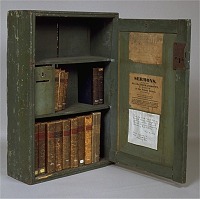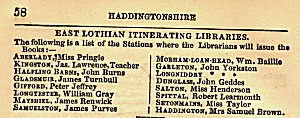Contents ![]() | Introduction
| Introduction ![]() | Institutes of learning
| Institutes of learning ![]()

Itinerating libraries
Page 1 of 2 | Next
By 1820 a subscription library was operating alongside Gray's Library (then considered the core of the Town Library) in Haddington. There were also a parish library and a mainly technical library operated as part of the School of Arts from 1823. However, in 1817, Samuel Brown, a local businessman, began a unique experiment.
Samuel's great idea
Samuel Brown (1779-1939) was known as the 'philanthropist' of Haddington. He was a champion of the social, educational, and religious welfare of his townsfolk. He was president and founder of Haddington School of Arts, part of a movement that set the pattern for mechanics institutions. He became concerned that many people in the East Lothian countryside did not have access to libraries. So in 1817 he introduced 'itinerating libraries', which were sent to nearby parishes. These were simply storage boxes fitted with shelves for around 50 volumes. By 1836, there were 47 sets circulating.

Most were looked after by local shopkeepers, schoolmasters, or other volunteers. The cabinets were rotated from place to place every two years. Nobody in East Lothian was then more than a few miles away from a reasonable stock of library materials, mostly practical, moral and philosophical works. The libraries were funded by donation and by subscription. In the first year borrowers paid a few pence per book, in the second borrowing was free.
Page 1 of 2 | Next
In this section:
Circulating libraries | Subscription libraries | Itinerating libraries | Free public libraries
Contents ![]() | Introduction
| Introduction ![]() | Institutes of learning
| Institutes of learning ![]()